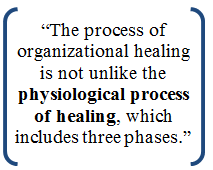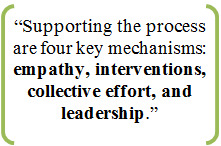How Organizations Heal After a Crisis
Editor’s note: We are pleased to welcome Professor Ned Powley of the Naval Postgraduate School, whose article “The Process and Mechanisms of Organizational Healing” was published in the Journal of Applied Behavioral Science March 2013 issue.
When faced with significant disruption, whether induced through human error, economic downturns, or natural disasters, organizations have the potential to heal. More than recovery or coping, organizational healing draws on positive organizational scholarship to explain how organizations can develop as virtuous human systems. The literature from resilience and post-traumatic growth help explain the process and mechanisms needed to restore trust, satisfaction, and shared leadership.
 The recent economic downturn in the U.S. real estate market prompted a new way to address the business disruption for one firm, Prudential Real Estate. After losing a combined $210 million between 2008 and 2009, the company had to find regenerative strength to bounce back and recover from the economic setback. “The Process and Mechanisms of Organizational Healing” explores the process Prudential followed to heal from the downturn. The process of healing is not unlike the physiological process of healing, which includes three phases.
The recent economic downturn in the U.S. real estate market prompted a new way to address the business disruption for one firm, Prudential Real Estate. After losing a combined $210 million between 2008 and 2009, the company had to find regenerative strength to bounce back and recover from the economic setback. “The Process and Mechanisms of Organizational Healing” explores the process Prudential followed to heal from the downturn. The process of healing is not unlike the physiological process of healing, which includes three phases.
1) Protective Inflammation: A focused response to crisis that activates resources to the wound site. That activation process then stabilizes the trauma, mitigates potential harm, and prepares the wound site for future growth. In organizations, the actions both organization leaders and members take to deploy social, organizational, and material resources to stabilize decline and decreased  performance, protect against potential threats, and prepare for additional stages of healing. There is a sense of urgency to restore the organization’s effectiveness and profitability, and the initial actions are meant to generate positive energy for change and growth.
performance, protect against potential threats, and prepare for additional stages of healing. There is a sense of urgency to restore the organization’s effectiveness and profitability, and the initial actions are meant to generate positive energy for change and growth.
2) Relational Proliferation: A rapid increase in connections that thereby begin to strengthen underlying networks, structures, and routines. This occurs through the activity of organization members who draw on and strengthen internal and external networks of relationships. Like the proliferation of collagen and the supportive function of connective tissue, relational proliferation enables the scaffolding for social networks by identifying, building, and strengthening key relationships that support the overall recovery.
 3) Remodeling: With a strong foundation, beneath the surface, additional growth makes the wound stronger than before. The wound does not simply resume a previous state, but increases in strength thus enabling protection and structural integrity. For organizations, remodeling refers to not only the resumption of former function, but generation of core strength in the organizational culture. Organization members engage in practices to cascade the positive culture and shared leadership throughout the organization.
3) Remodeling: With a strong foundation, beneath the surface, additional growth makes the wound stronger than before. The wound does not simply resume a previous state, but increases in strength thus enabling protection and structural integrity. For organizations, remodeling refers to not only the resumption of former function, but generation of core strength in the organizational culture. Organization members engage in practices to cascade the positive culture and shared leadership throughout the organization.
Supporting the process of organizational healing are four key mechanisms: empathy, interventions, collective effort, and leadership. Each of these mechanisms are at play throughout the process of healing. Empathy, for example, enables to support the inflammatory response. Individual members and organizational leaders demonstrate empathy for employees and customers who have been affected by the crisis. Interventions are required both from within and without the organizations in the inflammation and proliferation stages. For example, internal measures include steps to keep morale and satisfaction high. Externally, new leadership infuses the organization with new ideas and fresh perspectives that enable new growth pathways. Collective effort is needed from everyone in the organization, not just those from the top. Particularly during the remodeling phase, effort from all sectors within the organization produces energy for culture change. Finally, leaders both at the top and throughout the organization have a special responsibility to sustain each phase of the process. Leaders on every level represent a prime factor to ensure growth.
My work on organizational healing began when I studied a school shooting incident nearly 10 years ago. From that work, I have explored what it means not just to recover but to heal. Healing connotes a positive process of rebound and growth, not simply getting by. What’s potentially interesting here: For each phase of healing, there are both plusses and minuses. Inflammation is good if contained and supportive of the underlying growth, but too much inflammation (too much discussion of the problem, focusing on what is not working, or incendiary language) may indeed undermine the process. Proliferation is about growth and development, but too much, like cancerous proliferation, can overrun and possibly hinder strengthening of important social networks. And remodeling requires appropriate measures to ensure flexibility, without the structural or institutional strength, remodeling is incomplete and in the case of organizations, the culture does not serve as a unifying agent.
The paper concludes with a number of new avenues for research and makes a number of suggestions for leaders of organizations who face difficult situations.
Click here to read Professor Powley’s article, “The Process and Mechanisms of Organizational Healing,” in the Journal of Applied Behavioral Science.
































































































Interesting essay. There is a lot of smart people out there! 🙂 🙂